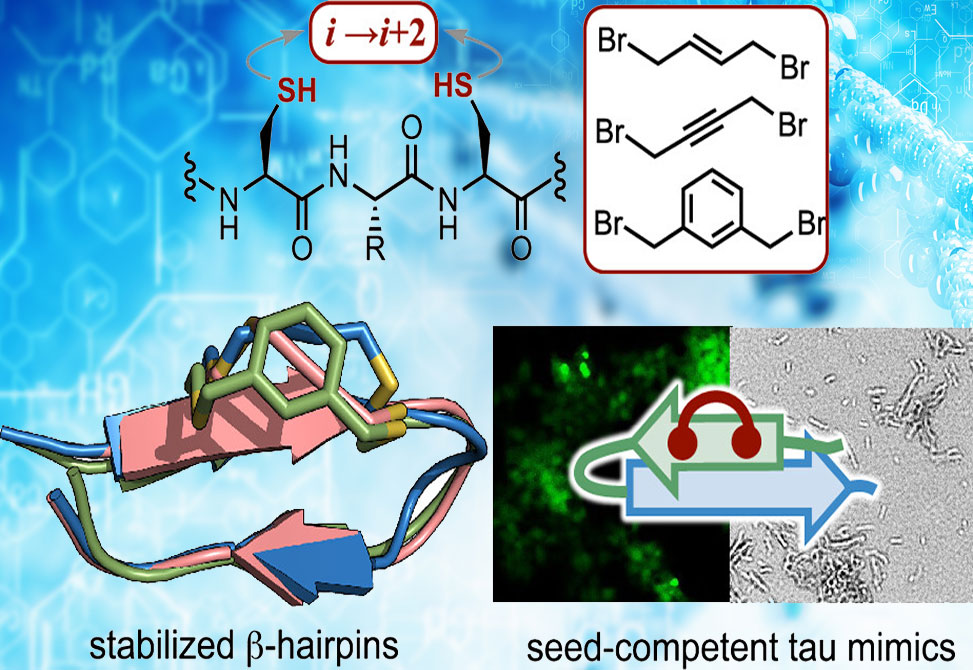Stapled Sheets
Reflecting work in the Del Valle Group
The stabilization of β-sheet structures has long been a challenge in peptide design, despite their central role in mediating protein–protein interactions, PPIs. While side-chain stapling is well-established for constraining α-helical, polyproline II, and loop conformations, its potential for reinforcing β-strand geometry has been far less explored. In this study, published in the Journal of the American Chemical Society, by first author Abha Dangi and colleagues in the Del Valle Group at the University of Notre Dame, the team systematically investigate i → i+2 intrastrand cysteine, Cys, stapling as a means to preserve canonical backbone torsions, maintain intact hydrogen-bonding edges, and even modulate amyloidogenic self-assembly — with direct implications for tau protein aggregation in neurodegenerative disease.
A Versatile Stapling Strategy
The authors selected three distinct peptide systems to probe the effect of Cys-based i → i+2 macrocyclization:
BHP-wt — a 12-residue autonomously folding β-hairpin featuring a D-Pro–Gly turn.
GB1-wt — a 16-residue hairpin from the B1 domain of Streptococcal protein G.
Tau-wt — a 21-residue β-arch segment from human tau, 294Lys–314Gln, containing the aggregation-prone 306VQIVYK311 hexapeptide motif.
In each case, selected i and i+2 positions were mutated to Cys, and the resulting di-Cys variants were cyclized with one of three high-performing bis-electrophiles: E-butenyl, butynyl, or m-xylyl. These were compared with poorly performing controls, for example, thioacetal linkers, to establish the influence of staple geometry on fold stability.
β-Hairpin Stabilization in Model Systems
In BHP-wt, di-Cys substitution without stapling reduced folding, as shown by downfield shifts in Hα resonances at reporter positions. Remarkably, stapling with E-butenyl, butynyl, or m-xylyl not only restored folding but, in some cases, increased the folded population beyond wild-type levels — reaching up to 93% folded with a ΔGfold shift of −1.46 kcal·mol−1.
High-resolution 1H NMR and NOE-restrained structure calculations confirmed antiparallel β-hairpin folds with canonical torsions, robust cross-strand hydrogen-bonding, and linker-dependent side-chain interactions — such as bifurcated H-bonds in VV-btyn and unique CH–π contacts in VV-mxyl.
The GB1-wt system, with longer strands and a different turn motif, showed similar stabilization trends. For both strand positions tested, the same three linkers yielded folded populations ≥88%, confirming that the effect is not limited to a single β-hairpin topology.
Application to Tau β-Arch Mimics
Tau is an intrinsically disordered protein implicated in microtubule stabilization, signaling, and mRNA translation. In pathological states, misfolding of tau into cross-β amyloid filaments drives neurodegenerative processes. The authors hypothesized that stabilizing a nonaggregation-prone segment of tau’s β-arch, 294Lys–300Val, could promote overall folding into an amyloid-competent conformation.
Three di-Cys tau variants — KN-ns, NK-ns, and KV-ns — were synthesized and stapled with the same three linkers. When tested in tau-YFP biosensor cells, all KV-series staples triggered robust intracellular tau aggregation, visualized as fluorescent puncta. The KV-btyn variant was the most potent seed, and activity was strictly dependent on the precise i → i+2 staple geometry; scrambled i → i+3 controls were inactive.
Amyloid Self-Assembly and Structural Transitions
In vitro, KV-ebut, KV-btyn, and KV-mxyl exhibited high Thioflavin T fluorescence within hours, indicating rapid fibril formation. CD spectroscopy revealed a transition from random coil (monomer) to parallel β-sheet, fibril, signatures after incubation in phosphate-buffered saline.
Negative-stain TEM confirmed the presence of short, filamentous aggregates for stapled variants, while tau-wt showed no aggregates. Interestingly, the PHF6 hexapeptide formed fibrils but could not seed tau in cells — emphasizing that amyloidogenicity and seeding competence are distinct properties influenced by β-arch context.
Conclusions and Outlook
This work demonstrates that i → i+2 intrastrand di-Cys stapling, with judiciously chosen linkers, is a powerful and synthetically accessible approach to stabilize β-sheet folds. Beyond model peptides, it can impart amyloidogenic self-assembly and prion-like seeding capability to otherwise nonaggregation-prone sequences.
Because the staples preserve backbone hydrogen-bonding edges — a key recognition surface in β-sheet PPIs — this strategy holds promise for designing minimalistic β-strand mimics that target disease-relevant aggregation pathways or disrupt pathogenic PPIs. Coupled with the established benefits of stapling for proteolytic stability and membrane permeability, these findings open a versatile platform for both fundamental β-sheet design and therapeutic intervention.


